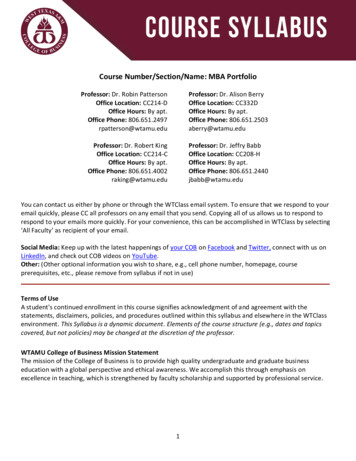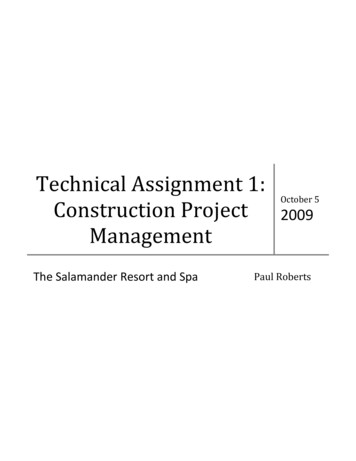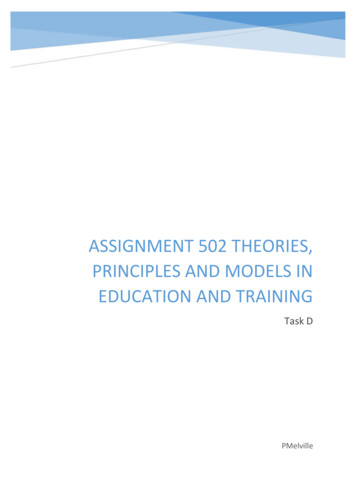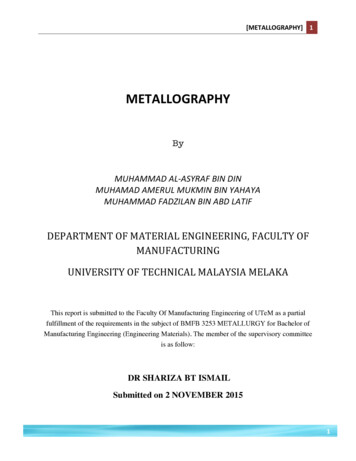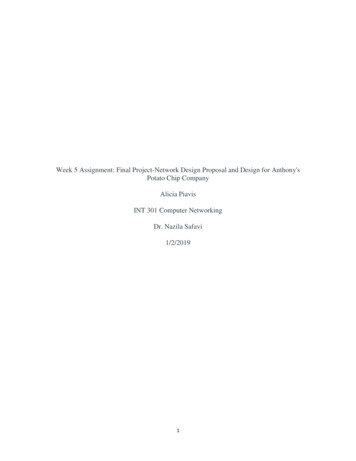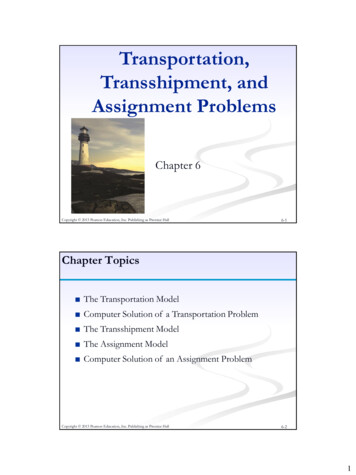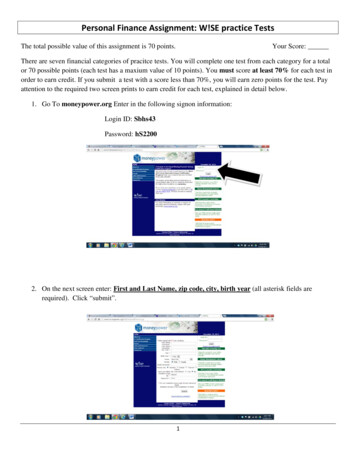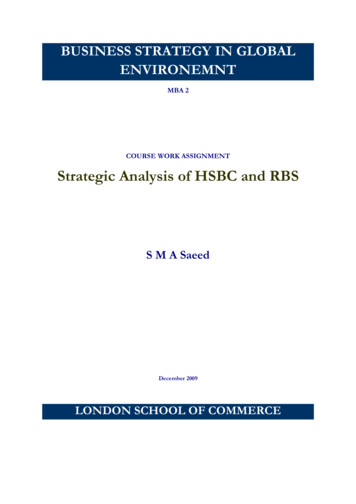
Transcription
BUSINESS STRATEGY IN GLOBALENVIRONEMNTMBA 2COURSE WORK ASSIGNMENTStrategic Analysis of HSBC and RBSS M A SaeedDecember 2009LONDON SCHOOL OF COMMERCE
Table of Contents1INTRODUCTION12THE ORGANIZATIONS22.1RBS Holdings12.2HSBC Holdings23LITERATURE REVIEW43.1Concept of Strategy and Corporate Strategy43.2Hierarchical Levels of Strategy43.3Schools of Strategy53.4Strategic Management and Strategy Process63.5Strategic Position73.6External Environmental Factors73.7Internal Environmental Factors---SWOT Analysis113.8Strategic Choices133.9Strategy in Action134CRITICAL EVALUATION154.1PESTEL Analysis of HSBC and RBS PLC154.2Porter’s Five Force’s Analysis of HSBC and RBS PLC164.3Analysis of Financial Performance174.4Internal Analysis185FUTURE STRATEGIES NCE & BIBLIOGRAPHY:22
1IntroductionGlobal organizations are diverse in terms of both products and geographic markets. Theyusually comprise range of different business in the form of subsidiary companies within aholding company structure or divisions within a multidivisional structure. Strategic decisionsmaking in global environment determine the overall direction of an organization and itsultimate viability in light of the predictable and unpredictable changes that may occur in itsmost important business environments.Global banking Industry has turn into powerhouse of economic growth creating ever morecomplex products that use risk and securitisation in business models. Banks, now a days areoffering diversified financing services along with traditional banking services like savings,deposit and transfer of funds. Some of the most extreme risk-taking and complex financialactivities of the banking industry are vulnerable to the over all health of the world economy.The two of the most important banks with respect to their global operations are Royal Bankof Scotland and HSBC. There global presence and diverse nature of operations, especiallyduring current economic circumstances, provide an opportunity to evaluate strategicmanagement models.The complex nature of business environment, services and regulation, under witch theseorganizations operate, made this report an interesting but challenging as well. After this briefintroduction, the second chapter of this report present the current business operation andoverview of the organizations. Third chapter is dedicated to the review of the academicliterature relevant to proceeding chapters and emphasizing the importance of the literary workcarried out by prominent management scholars. Fourth chapter critically examines the past,present and future strategies of Royal Bank of Scotland and HSBC, using various models forevaluating strategic, business and operational level activities. This chapter also evaluate theinternal and external forces shaping the business environment for each organization. Fifthchapter compares and contrast the evaluated outcome of third chapter. Last chapter isconclusion, summarizing the results and establishing the link between the organizationalperformance and their successful strategy formulation.1
22.12The OrganizationsRBS HoldingsThe Moto ‘Making it Happen’The Mission Statement “Our focus is on re-build standalone strength, we will achieve thiswith integrity, transparency, and by serving our customer well.” (RBS, Annual Report 2008)2.1.1Business Aims and ObjectivesThe group aims to become world’s premier financial institutions with global clientele, to AAcategory standalone credit status and to rebuild shareholder value, along the way enabling theUK Government to sell down its shareholding. (RBS, Annual Report 2008)The groups objective include; focusing activities on top level competitive positions ensuringdurable customer franchises, targeting 15% return on equity in our businesses, organicgrowth of business, establishing business model that reinforce each component sharedproducts, customers and expertise and proportionate use of balance sheet, funding and risk2.1.2Business OverviewThe Royal Bank of Scotland Group plc (or RBS) is the holding company of one of theworld's largest banking and financial services groups. The group operates from the UK, USand internationally through its two principal subsidiaries, the Royal Bank and NatWest. In theUS, the group operates through its subsidiary Citizens. It is headquartered in Edinburgh, UKand employs about 199,500 people.RBS is a diversified financial services organisation engaged in banking and financialactivities across the globe through these divisions; Global Markets, Regional Markets, USRetail & Commercial Banking, Europe & Middle East Retail & Commercial Banking, AsiaRetail & Commercial Banking and RBS Insurance and Group Manufacturing.2.2HSBC HoldingsThe Moto ‘The World's Local Bank’2
The Mission Statement ‘Providing outstanding customer service; effective and efficientoperations; maintaining strong capital and liquidity by prudent lending policy and strictexpense discipline’ (HSBC Annual Report 2009)2.2.1Business Aims and ObjectivesThe group aims to achieve the highest personal standards of integrity and commitment totruth and fair dealing, esteemed commitment to quality and competence and compliance withall laws and regulations wherever it conduct its business.2.2.2Business OverviewHSBC Holdings plc employs about 312,866 people providing financial services to 100million customers in 80 countries and territories in the world. The Hong Kong and ShanghaiBanking Corporation despite its name has Scottish origin. HSBC primarily operates inEurope and Hong Kong with its headquarters in London and listings on the London, HongKong, New York, Paris and Bermuda stock exchanges. With assets of about 2,527 billion at2008, HSBC is one of the world's largest banking and financial services organizations.(HSBC Holdings, Annual Report 2008)3
3Literature Review3.1Concept of Strategy and Corporate Strategy3.1.1What is StrategyStrategy is “the direction and scope of an organisation over the long term, which achievesadvantage in a changing environment through its configuration of resources and competenceswith the aim of fulfilling stakeholder expectations.” (Johnson, G 2008)3.1.2Corporate strategyCorporate strategy is “the pattern of decisions in a company that determines and reveals itsobjectives, purposes or goals, produces the principal policies and plans for achieving thosegoals, and defines the range of business the company is to pursue, the kind of economic andhuman organization it is or intends to be and the nature of the economic and non-economiccontribution it intends to make to its shareholders, employees, customers and communities.”(Johnson, G 2008)3.2Hierarchical Levels of StrategyStrategy has three different levels.The top level is corporate-level strategies, concerned with the overall purpose and scope ofan organisation and how value will be added to the different parts of the organisation.Business-level strategies are about how to compete successfully in particular markets alsocalled a “competitive strategy”. It relates to particular strategic business units (SBUs) withinthe overall organisation. A strategic business unit is a part of an organisation for which thereis a distinct external market for goods or services that is different from another SBU. Thethird level of strategy is operational strategies, which are concerned with how effectivelythe component parts of an organization deliver the corporate- and business-level strategies interms of resources, processes and people. In most businesses, successful business strategiesdepend to a large extent on decisions that are taken, or activities that occur, at the operationallevel.4
3.3Schools of StrategyMintzberg, Ahlstrand and Lampel discuss various approaches to strategic planning and theyidentify 10 different schools of thought which are divided into Prescriptive and Descriptive.We can apply Prescriptive schools for Strategy formulation and Descriptive School forStrategy formation.3.3.1Prescriptive SchoolsPrescriptive means “what can be done most realistically”. The prescriptive strategy takesother factors into consideration while analyzing multiple criteria and conflicting objections.After this, then chooses what strategy would or could be done realistically based on theobjectives previously listed. According to the prescriptive strategy, the second best decisionmight be more appropriate. The prescriptive approach includes an analysis of possibledecisions around a chosen solution known as sensitivity analysis.3.3.2Design School:This approach regards strategy formation as a process of conception, matching the internalsituation of the organization to the external situation of the environment. Thus the strategy ofthe organization is designed to represent the best possible fit.3.3.3Planning School:Here strategy formation is seen as a formal process, which follows a rigorous set of stepsfrom analysis of the situation to the development and exploration of various alternativescenarios.3.3.4Positioning School:Under this approach, which is very heavily influenced by the works of Michael Porter,strategy formation as an analytical process places the business within the context of theindustry that it is in, and looks at how the organization can improve its competitivepositioning within that industry.3.3.5Descriptive SchoolsDescriptive means “what is usually done”. The descriptive strategy is done based on pastevidence. It is something that has been most likely done in the past.5
3.3.6Entrepreneurial School:This approach regards strategy formation as a visionary process, taking place within the mindof the charismatic founder or leader of an organization.3.3.7Cognitive School:This approach, based upon the science of brain functioning, regards strategy formation as amental process, and analyzes how people perceive patterns and process information.3.3.8Learning School:This school of thought regards strategy formation as an emergent process, where themanagement of an organization pays close attention to what works and doesn't work overtime, and incorporates these 'lessons learned' into their overall plan of action.3.3.9Power School:Here strategy development is seen to be a process of negotiation between power holderswithin the company, and/or between the company and external stakeholders.3.3.10 Cultural School:This approach views strategy formation as a collective process involving various groups anddepartments within the company; the strategy developed is thus a reflection of the corporateculture of the organization.3.3.11 Environmental School:Here strategy formation is seen to be a reactive process: a response to the challengesimposed by the external environment.3.3.12 Configuration School:In this final approach, the purpose of strategy formation is seen as a process of transformingthe organization from one type of decision-making structure into another.3.4Strategic Management and Strategy ProcessThe strategic management is the conduct of sketching, implementing and evaluating crossfunctional decisions that will enable an organization to achieve its long-term objectives.6
“Strategic management is an ongoing process that evaluates and controls the business and theindustries in which the company is involved; assesses its competitors and sets goals andstrategies to meet all existing and potential competitors; and then reassesses each strategyannually or quarterly [i.e. regularly] to determine how it has been implemented and whether ithas succeeded or needs replacement by a new strategy to meet changed circumstances, newtechnology, new competitors, a new economic environment., or a new social, financial, orpolitical environment”. (Lamb, 1984)3.5Strategic PositionThe strategic position is concerned with the impact on strategy of the external competitiveenvironment, an organisation’s strategic capability and the expectations and influence ofstakeholders. There are external and internal factors that have to be taken into account at theoutset of strategy development. On the external side, environmental factors are what mattersmost to success: strategy development should be primarily about seeking attractiveopportunities in the marketplace. On the other hand, internal approach is about anorganization’s specific strategic capabilities, resources or cultures should drive strategy.3.6External Environmental FactorsThe organization exists in the context of a complex political, economic, social, technological,environmental and legal world. Many of those variables will give rise to opportunities andothers will exert threats on the organization or both. Therefore it is necessary to distil out ofthis complexity a view of the key environmental impacts on the organization. The externalcompetitive environment is what gives organisations their means of survival. Theseenvironmental frameworks are organized in a series of layers as shown in the exhibit 1:7
(Source: Chapter 2.1, Exploring Corporate Strategy by Johnson, Scholes andWhittington)Exhibit13.6.1PEST AnalysisA PEST analysis is an analysis of the external macro-environment that affects all firms. Suchexternal factors usually are beyond the firm's control and sometimes present themselves asthreats. It is important to analyse how these factors are changing now and how they are likelyto change in the future, drawing out implications for the organisation.(i) Political Analysis Political stability Legal framework for contract enforcement Intellectual property protection Trade regulations & tariffs Taxation - tax rates and incentives Wage legislation - minimum wage and overtime(ii) Economic Analysis Type of economic system in countries of operation Government intervention in the free market Comparative advantages of host country Exchange rates & stability of host country currency8
Efficiency of financial markets Inflation rate Interest rates(iii) Social Analysis Demographics Class structure(iv) Technological Analysis Rece
Banking Corporation despite its name has Scottish origin. HSBC primarily operates in Europe and Hong Kong with its headquarters in London and listings on the London, Hong Kong, New York, Paris and Bermuda stock exchanges. With assets of about 2,527 billion at 2008, HSBC is one of the world's largest banking and financial services organizations. (HSBC Holdings, Annual Report 2008) 4 3333 .




